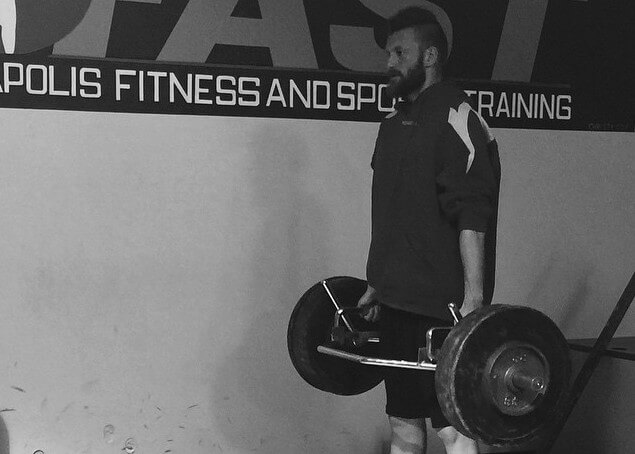I don’t know about you, but when I went to school there wasn’t a textbook or a course for coaching.
We could get all the anatomy, physiology and biomechcanics that our little heart desired.
But when it came down to the nitty gritty details of helping a real, live person get better?
Sorry, but that was never covered.
When it comes to coaching, we’re forced to lean on either great mentors, or our own personal experiences, to help us evolve into the kind of coach we all want to become.
I was blessed to come across some great people over the years, people that helped me really understand the X’s and O’s of training, but I never had someone to mentor me when it came to coaching.
Unfortunately, a lot of this stuff was learned the old fashioned way:
By making a ton of mistakes!
This post is a compilation of mistakes that either I’ve made, I’ve seen interns make, or things that I see going on these days in the coaching world. Enjoy!
The Don’ts
Don’t Use Technical Jargon
This is something that we’ve always struggled with at IFAST.
Bill, myself, and our entire staff pride ourselves on knowing and understanding the human body. We want to know the biomechanics, the physiology, and all of the geeky science details that make us work.
Which is all fine and dandy – until you start trying to use technical or science-heavy verbiage with your clients.
For example, if you catch yourself saying something like this, it may be time to reevaluate:
“Oh your issues are due to your hyperlordosis, an anterior pelvic tilt, and the fact that your pubcococygeus muscle is poorly positioned.”
When it comes to training knowledge, you have to own the material. It’s not enough to understand it yourself – you have to own the material so that you can help your athletes understand what it is you’re trying to accomplish.
This could be via watering the concept down, using analogies, or any host of other methods.
But whatever you don’t, don’t try and show how smart you are by using a bunch of big words. At best, you’ll intimidate an athlete and make them less likely to ask further questions.
And in a worst case scenario, you’ll alienate them and lose them for good.
Don’t Overcue
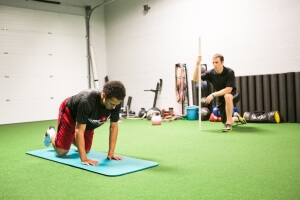 Every new group of interns has a specific life cycle that they go through.
Every new group of interns has a specific life cycle that they go through.
Towards the middle of their internship, there’s a ton of overwhelm because they are taking in so much new information. They are starting to know what they don’t know, see what they didn’t see before, and they feel compelled to fix every single issue during a training session.
But here’s the thing – you can’t do this!
Not only is it impossible to fix everything in one session, but it often overwhelms the athlete standing in front of them every bit as much.
When I start to see an intern or young coach do this, I immediately tell them to focus on one BIG thing that will fix multiple little issues.
In the FMS world, you’ve seen this: Fix one of the lower tiered tests (ala straight leg raise or shoulder mobility), and you can see changes throughout multiple tests to boot.
This is how coaching and cuing should work as well. Find one big thing, fix it, and move on.
Don’t Be Silent
On the flip side of coaching too much, there’s absolutely the issue of coaching too little as well.
Let’s say you have someone with great technique – they’re just really dialed in and you don’t feel like there’s anything you want to fix.
Do you stand their like an automaton? Staring at them for five, six, or eight reps?
I sure hope not!
Even if you don’t have anything technical to fix, you can still give your athletes feedback or motivation throughout the set.
“Awesome work, Ben,”
“Way to feel your whole foot, Sue.”
“Looks great Jimmy – keep going!”
In fact, if you have clients long enough this is where a large majority of your coaching should end up.
They should move well, and they should understand the principles behind even new movements or exercises that you introduce them to.
So while the degree of coaching and cuing may diminish, you still provide feedback and motivation to keep them interested and engaged.
Don’t Talk Incessantly
I think most of the veteran coaches reading already know this, so it’s more for the younger coaches out there.
When you are going through a training session, there’s a give-and-take in the dialogue. A good rule of thumb is 2/3rds to 1/3rd:
They talk 2/3rds of the time, you talk 1/3rd of the time. (More on this below in the “Build Relationships” section.)
Young coaches talk too much early on in their careers because they don’t understand people yet.
An athlete could ask you a question to be polite and/or enhance a conversation. It’s your job as a coach to give them enough to continue the dialogue, without giving a magnum opus about what’s going on in your life, your opinion, or to bitch and moan about what’s wrong with your life and the world.
Now keep in mind, this isn’t a hard and fast rule. In fact, there are times you should absolutely talk a little bit more, to open up, and let your athletes know what you’re all about.
What you’ll find is that in these times, the conversation is very light, easy and spirited. You’re talking more about your craft, your passion, etc. – not just blindly talking about yourself.
But if you find yourself endlessly droning on and on about you, how the world is out to get you, etc., it’s time to take a step back and recognize who the focus of the session should really be on.
The Do’s
Start Coaching Early
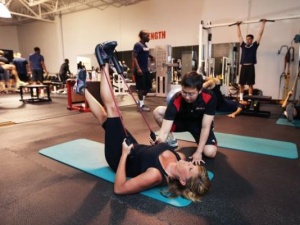 If you’ve followed the R7 Approach to Training, you’ll notice that there is a build up in the training process.
If you’ve followed the R7 Approach to Training, you’ll notice that there is a build up in the training process.
You release, you reset, and then you ready yourself for the training session at hand.
But too often, coaches assume the training session doesn’t start until someone is running, jumping, throwing something, or lifting something heavy – and this is absolutely not the case!
The training session begins the second the athlete walks in the door.
Note their body language, speed of gait, and how they interact with people upon walking in the door.
Chat them up during their “release” work – how was their night/weekend?
How is their body feeling?
Coach and cue them during their resets. If this stuff is important, make it a focus and get them to do it right each and every time.
You get the jist of this, but here’s a real world example.
Right now I’ve got about eight pro soccer guys that are all training around the same time. One guy just got back into town last week, so I was chatting him up and seeing how his Christmas and New Years were.
At the opposite end of the gym, I could see another doing a reset and he wasn’t in the best position. I tried to cue him from across the gym, but the fix wasn’t ideal.
Later that day, he said he was struggling a bit that day and didn’t feel like he was as loose or as mobile as he should’ve been.
Not an epic fail, but definitely a failure on my part. I did better the next time.
The coaching session starts the second an athlete walks in the door. Get them started off on the right foot and you’re guaranteed to have a better training session throughout.
Be Ready to Adapt and Modify
As a young coach, you take a ton of pride in your program design.
You meticulously calculate volume, wave the intensity, and make sure every tempo and rest period is on point.
But what happens when the athlete isn’t prepare to do what’s on the workout that day?
Running an athlete through a session isn’t coaching – that’s executing.
For example, if an athlete was out the night before, just broke up with their significant other, or has 25 tests in the next two weeks, then today might not be the day to push them.
Your job as a coach is to take the athlete standing in front of you and give them the best training session that they are capable of doing today.
Sometimes that’s running faster than ever before, hitting PR’s, and basically dominating life.
And on the flip side, there are other times when the best training session possible are some resets, a light warm-up, and some steady state cardio to get them feeling good again.
The training process is a dynamic process, which just so happens to include one of the biggest variables of all:
People.
Be Active
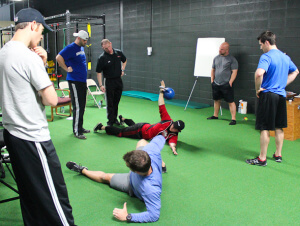 When it comes to training, we know that the sagittal plane “unlocks” the frontal and transverse planes.
When it comes to training, we know that the sagittal plane “unlocks” the frontal and transverse planes.
As such, the sagittal plane must come first.
Unfortunately, this can really limit the quality of your coaching. I’ve seen this a lot with our interns – they know that the sagittal plane is important, but they just camp out there for the entirety of a set. It’s like their feet are stuck in cement.
Here’s something to remember:
Just because the sagittal plane is important, doesn’t mean it’s the only angle that we coach from!
Instead, be active. Clean up something in the sagittal plane, and then move around to the front or back and see how they’re moving there as well.
Not only does moving around give you more feedback on their movement quality, but it also helps keep the athlete engaged, too. It makes them feel like you’re working harder, and that you’re focused on getting them results.
Be Excited to Coach
I’m not sure how much emphasis I need to put on this, but I’m going to throw it out there.
As coaches, we have an awesome job that we look forward to each and every day.
We’re not chained to a desk, we’re not surrounded by people without ambition, and we don’t have to constantly look to Friday for a break.
We get the privilege of helping our athletes becoming more awesome, each and every day.
As such, why wouldn’t you be excited about going to work?
Why wouldn’t you be excited about helping the people you coach get better?
This is really simple – we’ve got an awesome job. Be excited to coach, and your athletes will feed off it.
Make Them Feel Successful
I don’t care who you work with, no one likes to feel like a failure.
Even the most determined and competitive athletes I’ve trained, people who know that failure is important for long-term success, don’t want to walk out of the gym every day feeling defeated.
Find ways for your athletes to be successful in every training session.
The best example here comes to progressions and regressions. If someone is struggling to do a split-squat, why on Earth would you program a reverse lunge to overhead press?
Find exercises and situations that make them feel successful, and then acknowledge their success.
“Wow Joe you crushed that – awesome work! Now let’s try something a little bit harder…”
If you do this correctly, not only will you build their confidence in themselves, but their confidence in you as a coach as well.
Build Relationships
I don’t care how many years you go to school, or how many letters you have after your name, this is something that I’ve never seen touched on in a lecture or con ed course.
Build relationships.
Get to know the human being standing across from you.
Because as cliche as this saying is, it’s true:
They don’t care how much you know, until they know how much you care.
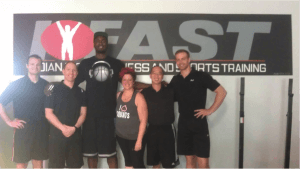 At no point in my coaching career was this more obvious than when I trained Roy Hibbert in 2013.
At no point in my coaching career was this more obvious than when I trained Roy Hibbert in 2013.
First off, the guy is 7’2″, makes a shit ton of money, and is on my hometown Pacers team that could conceivably win an NBA Championship.
So the whole first week I’m basically pee-my-pants scared, which is definitely not a good feeling.
And the first couple of weeks were rough, as we were both feeling each other out. Unfortunately a lot of the pros I’ve worked with are reserved early on, as they have to protect themselves.
And for me as a coach, I’m trying to figure out the best way to build rapport and show this guy that I know what I’m doing, but that I also genuinely care about them as human beings.
It took about a few weeks, but from there out Roy and I had a really strong relationship. This happened (I believe) because he knew my only goal was to help him become the best basketball player he could be.
Your goal as a coach is to build a relationship with every athlete you come in contact with.
And just like every athlete is different, the relationship you have with each one will be different and unique as well.
Of all the things I talk about in this post, this is arguably the most important – because if you never build a relationship with your athletes, they won’t stick around long enough to find out what you “know.”
Summary
Okay I’ve talked long enough, but I sincerely hope you got a thing or two from this article.
Last but not least, if you know a coach (or coaches) who would benefit from this article, please take a moment to share this with them.
Now get out there and coach somebody!
All the best,
MR

